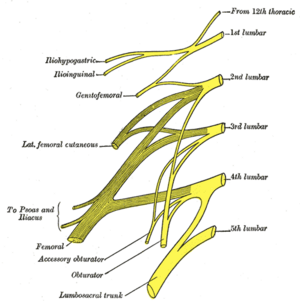Genitofemoral Nerve
Original Editor - Mohit Chand
Top Contributors - Mohit Chand, Kim Jackson and Aminat Abolade
Introduction[edit | edit source]
The genitofemoral nerve originates from the lumbar plexus, emerging within the psoas major muscle by combining the anterior rami of the L1 and L2 spinal nerves at the lumbar spine. Descending through the retroperitoneum, it divides into genital and femoral terminal branches. These branches provide sensory innervation to the skin covering the anterior scrotum or labia majora and the lateral femoral triangle, respectively.
Anatomy[edit | edit source]
Origin[edit | edit source]
The genitofemoral nerve (GFN) arises from the lumbar plexus, emerging within the psoas major muscle by combining the anterior rami of spinal roots L1 and L2 of Lumbar spine.[1]
Course[edit | edit source]
The GFN passes downwards within the substance of the psoas major muscle, eventually emerging on the muscle's anterior surface, and possibly the psoas minor muscle when present, deep to the psoas fascia.
In the retroperitoneum, the GFN lies posterior to the ureter, gonadal vessels, and abdominal vessels. On the left, the nerve passes deep to the left ureter and gonadal vessels, left colic artery, and the inferior mesenteric vein. On the right, the nerve passes deep to the right ureter and gonadal vessels, and the ileocolic artery and vein. Just above the inguinal ligament, both left and right genitofemoral nerves perforate the psoas fascia and divide into genital and femoral branches.[1]
Function[edit | edit source]
- The femoral branch supplies sensory cutaneous innervation to the skin of the upper anterior thigh.
- The genital branch innervates the cremaster muscle of the spermatic cord in males and the mons pubis, labia majora, and adjacent thigh in females.
The cremasteric reflex is a function of genitofemoral nerve innervation.[2]
Clinical Significance[edit | edit source]
The genitofemoral nerve is susceptible to injury in various situations, including:
- Groin Injury: Laceration can occur during penetrating trauma, knife wounds, or surgical exploration of the groin. Surgical procedures on the saphenous vein, such as varicose vein ligation, may cause abrasive injury with retractors.[3]
- Inguinal Hernia Repair: Injuries can occur during inguinal hernia repair in the inguinal canal. In many cases, the injury is not immediately apparent during surgery but becomes evident postoperatively when the patient experiences pain.[4]
- Motor Vehicle Accidents: Injuries to the genitofemoral nerve can happen during a motor vehicle accident, particularly when there is lower back injury with extension while seated.
- Heavy Lifting: Lifting heavy objects is another potential cause of genitofemoral nerve injury.
- Spinal Issues: Conditions such as spinal stenosis of the L1 or L2 segments, compression fractures, or metastatic lesions in the lumbar spine can lead to injury of the nerve roots giving rise to the genitofemoral nerve.
- Psoas Abscess: Conditions like a psoas abscess, which may occur after an open pelvic fracture or a retroperitoneal hematoma, can cause irritation of the genitofemoral nerve.
Anatomical Variation[edit | edit source]
Almost 50% of genitofemoral nerves examined in cadaveric studies demonstrated an anatomical variation.
In about 20% of cases, nerves bifurcated prematurely, occurring at the upper portion of the anterior surface of the psoas major muscle instead of the mid-portion. Occasionally, the genital and femoral branches did not converge into a common trunk within the psoas muscle but remained distinct nerves as they entered the pelvis.[5]
References[edit | edit source]
- ↑ 1.0 1.1 Iwanaga J, Simonds E, Schumacher M, Kikuta S, Watanabe K, Tubbs RS. Revisiting the genital and femoral branches of the genitofemoral nerve: Suggestion for a more accurate terminology. Clinical Anatomy. 2019 Apr;32(3):458-63.
- ↑ Mellick LB, Mowery ML, Al-Dhahir MA. Cremasteric Reflex. [Internet]. 2023. [cited 4 January 2024]. Available from: https://www.ncbi.nlm.nih.gov/books/NBK513348/
- ↑ Zhu CL, Zhong H, Li CH. Anatomic application of the genitofemoral nerve in uroandrological surgery. Zhonghua nan ke xue= National Journal of Andrology. 2017 Mar 1;23(3):276-9.
- ↑ Cirocchi R, Henry BM, Mercurio I, Tomaszewski KA, Palumbo P, Stabile A, Lancia M, Randolph J. Is it possible to identify the inguinal nerves during hernioplasty? A systematic review of the literature and meta-analysis of cadaveric and surgical studies. Hernia. 2019 Jun 1;23:569-81.
- ↑ Anloague PA, Huijbregts P. Anatomical variations of the lumbar plexus: a descriptive anatomy study with proposed clinical implications. The Journal of manual & manipulative therapy. 2009;17(4):e107.







